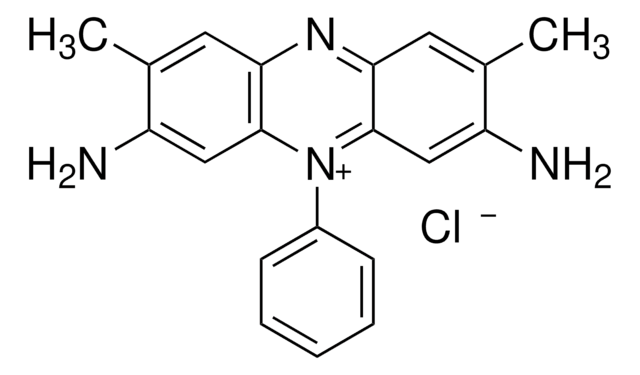V5265
Crystal Violet Solution
1%, aqueous solution
About This Item
Productos recomendados
form
aqueous solution
concentration
1%
technique(s)
microbe id | staining: suitable
color
deep violet, purple
Amax
0.36-0.44 at 589-594 nm
application(s)
diagnostic assay manufacturing
hematology
histology
storage temp.
room temp
SMILES string
[Cl-].CN(C)c1ccc(cc1)\C(c2ccc(cc2)N(C)C)=C3/C=C\C(C=C3)=[N+](/C)C
InChI
1S/C25H30N3.ClH/c1-26(2)22-13-7-19(8-14-22)25(20-9-15-23(16-10-20)27(3)4)21-11-17-24(18-12-21)28(5)6;/h7-18H,1-6H3;1H/q+1;/p-1
InChI key
ZXJXZNDDNMQXFV-UHFFFAOYSA-M
¿Está buscando productos similares? Visita Guía de comparación de productos
General description
It stains the fatty portions of sebaceous sweat a deep purple color. Crystal violet can also be used to enhance bloody fingerprints. This dye is harmful if inhaled, swallowed or absorbed through skin, contact may cause cancer, severe eye irritation in human beings.
Application
- Crystal violet is commonly used in Gram staining for the classification of bacteria.
- It has also been used to detect bacterial adherence to biomedical polymers and to stain DNA in mammalian tissues in Giemsa staining.
- It has been successfully used to develop a counterion-staining method to detect DNA in agarose gel electrophoresis.
- Its antimicrobial properties have facilitated its use in the treatment of oral candidiasis, skin infections, and methicillin-resistant Staphylococcus aureus.
- It has been used as a stain in cell proliferation assays, migration assays, and Boyden chamber assay.
Biochem/physiol Actions
Principle
signalword
Warning
hcodes
Hazard Classifications
Aquatic Chronic 3 - Carc. 2 - Eye Irrit. 2
Storage Class
12 - Non Combustible Liquids
wgk_germany
WGK 2
flash_point_f
Not applicable
flash_point_c
Not applicable
Elija entre una de las versiones más recientes:
¿Ya tiene este producto?
Encuentre la documentación para los productos que ha comprado recientemente en la Biblioteca de documentos.
Los clientes también vieron
Contenido relacionado
Visión de conjunto de la ciencia y la práctica de la bacteriología en el diagnóstico clínico. Más información sobre la aplicación de colorantes convencionales y especiales para el análisis microscópico.
An overview of the science and practice of bacteriology in clinical diagnostics. Learn more about the application of standard and special stains for microscopic analysis.
Nuestro equipo de científicos tiene experiencia en todas las áreas de investigación: Ciencias de la vida, Ciencia de los materiales, Síntesis química, Cromatografía, Analítica y muchas otras.
Póngase en contacto con el Servicio técnico






